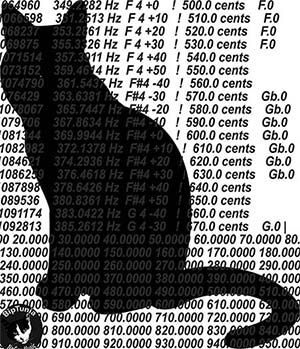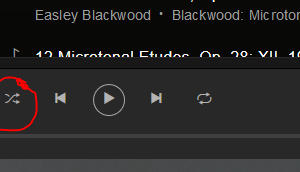Making Microtonal Music is Easier Than You’d Think
(This is an archive of an article previously published on the Produce Like a Pro site.
Before editing, please read the top part of this article's Talk page, here.
Thank you.)
Welcome to this Tutorial Tuesdays article by Michael W. Dean, synth player in BipTunia. Author of $30 Music School.
PRO TIP: I'd recommend that while you read this article, you listen to this Microtonal Playlist on Spotify. It has almost 1500 microtonal songs by many artists in many microtonal tunings, and in many genres. It will make a lot of this make more sense. Because, you know, 'Writing about music is like dancing about architecture.' (Absolute origin of that quote is indeterminate.)
And put the Spotify playlist on Shuffle:
YOUR MICROTONAL CALL TO ACTION:
Wanna do one simple thing that will immediately break you out of any musical rut you can imagine? And it's one thing one that will, in some ways, make you feel like you're just starting to play music again, in a good way. But will incorporate the writing, playing and engineering skills you've already developed? Plus you can make some darned cool music that doesn't sound like everything else. Then make some microtonal music!
WHAT IS MICROTONAL MUSIC?
Microtonal Music is music that does not use the standard 12-tone equal temperament of 'normal' Western music. 12-Tone Equal Temperament, or 12 TET, does covers everything from later period classical music to the Sex Pistols. From Queen to Drake. From Chuck Berry to Radiohead, to almost certainly the project you have open right now in your DAW.
12-TET is also called 12-EDO. EDO means 'Equal Divisions of Octave.' 12-EDO has been rediscovered multiple times in the West and China, and was known even to Galileo. (Per Mike Battaglia) Galileo's father Vincenzo Galilei, was one of the first popular advocates for twelve-tone equal temperament. He wrote pieces for 12-EDO in 1584.
More on 12-EDO, and EDOs in general is here. Most western musicians make music in 12-EDO. Few well-known contemporary musicians use other systems, known collectively as microtonal systems.
The correct phrase is microtonal systems, but it is used interchangeably by many with the phrase microtonal temperaments. Also used are the terms microtonal scales, microtonal tunings, neither of which are as accurate as saying microtonal systems or microtonal temperaments.
Accurate, but less used, are the phrases "microtonal pitch systems", "microtonal harmonic languages", or " microtonal approaches to organizing pitch." A few exceptions to the 'not much microtonal music in the mainstream' rule are King Gizzard & The Lizard Wizard, who made a microtonal album called Flying Microtonal Banana. And Aphex Twin has used microtonal tunings here and there on albums as far back as 1994. Richard James (Aphex Twin) recently did some microtonal consulting for Korg, making microtonal tuning systems for the next Monologue hardware synth, which will have microtonal capacity.
WHERE DID ALL THIS COME FROM?
Before the mid-17th century, artists used a variety of tuning systems. Most common in Europe was a system called Meantone Temperament (or just Meantone) which sounded good in many keys, but out of tune in other keys.
While it's easy for a talented musician to re-tune into different microtonal systems on a fretless instrument like a violin, or a slide instrument like the trombone or slide guitar, playing different tunings on a mechanical keyboard requires completely re-tuning the instrument for every key change. With digital synths and VSTs, it's much easier now to re-tune on the fly. I'll cover this later in the article.
12-EDO (12-TET) is a compromise, where every key is slightly out of tune, but you can transpose from key to key without things sounding more out of tune.
We are used to 12 TET, so it sounds 'right' to us. And now, the old way of doing it, meantone, Just Intonation (JI), are considered part of microtonal music.
A friend of mine, on first making microtonal music, said "I really like this, but listening to it makes me feel funny."
That feeling passes and turns to glee after about 12-24 total hours of listening to microtonal music.
No single person invented meantone. But Italian music theorist and composer Gioseffo Zarlino (1517-1590) is commonly credited with nailing it down and making it more widespread. This was, of course, during the Renaissance, when a lot of good things happened. Zarlino was also a supporter of 12-EDO.
Microtonal music can sound calm or it can sound otherworldly, depending on the tuning(s) used, and the musician. It can also be in any genre.
There is neo-classical microtonal acoustic guitar, like Tolgahan Çoğulu. There are futurists like Carlo Serafini'who plays the very cool and freaky looking Opal Chameleon MIDI keyboard. It looks a bit like a Mahjong game in play crossed with a Lite-Brite. It's not cheap ($3,300 USD without any of the available custom features), but it's amazing if you can master it.
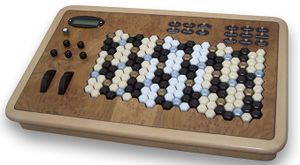
Then there's microtonal punk rock like the band Jock Tears. Well, pretty much only Jock Tears. They have cool tunes, a great look, and the best punk band name ever. (And I heard all the band names when I was in a punk band called The Beef People back in 1985.)
Naegleria Fowleri is microtonal heavy metal with a parrot singing!
There's microtonal blues, like Jon Catler.
I love this genre-busting analog video of Johnny Reinhard conducting a chamber choir of conch-shell players blowing some microtonal music....In a church, no less.
One of my favorite microtonal musicians is Brendan Byrnes, who makes music that's almost prog rock, but without 'too many notes for the royal ear.'
The microtonal music I make with BipTunia is some sort of synth pop.....with Phil Wormuth, an excellent poet (yes, there is such a thing) talking on many songs. It's hard to nail down, and is almost a different genre on every song. Plus a lot of it is a different microtonal tuning, or several microtonal tunings, in each song. It certainly doesn't sound like other music. No one I named here does.
Here's a web player for one of my records, with info on the microtonal tuning(s) used on each song.
There are so many good musicians making microtonal music that I can't list them all here. But most of them are in the Spotify playlist at the top of this article. And here's an alphabetic list of most of them, with links to each.
WHAT ABOUT WORLD MUSIC?
A lot of music on this planet is microtonal, you probably just don't hear a lot of it if you mostly listen to Western music.
Indian classical music is microtonal. Some sitars even have movable frets to change tunings for different pieces. A lot of traditional Asian music is microtonal. A lot of Middle Eastern music is microtonal.
To be clear, some of it is actually macrotonal, meaning it has less than 12 notes per octave. Microtonal is technically more than 12 notes per octave. Though the term is so commonly used for both that it's hardly incorrect to use on either.
A lot of traditional Asian music is pentatonic, being built off of macrotonal systems with 5 notes per octave. But that's commonly called microtonal. And sometimes microtonal music doesn't even have octaves. Or isn't an equal division of octaves, instead having some intervals larger or smaller in the same octave. Or the scale center can be divided over more than an octave.
ARE YOU EXPERIENCED WITH XEN?
Microtonal music pioneer Ivor Darreg (1917-1994) proposed the alternate term Xenharmonic Music, (pronounced like "Zen Harmonic"). Xenharmonic music, commonly just called "Xen" (pronounced "Zen"), includes microtonal, macrotonal, just intonation, non-octave systems...basically anything that is not 12 TET.
The term Xenharmonic comes from Xenos (Greek for foreign) and Xenia (Greek for hospitable). Xenharmonic is a good term, because microtonal music can often sound strange, but simultaneously welcoming. However, it's a strange term to people who are not microtonal musicians. It requires explanation. The term xenharmonic is largely only used by xenharmonic / microtonal musicians. Everyone else basically says microtonal.
All ancient music would be considered microtonal too. There are some ancient Greek tuning files included in the VSTs I make.
OK, LET'S GET XENHARMONIC
I'm going to cover four ways to get into microtonal music, involving increasing amounts of complexity / cost.
--The first method, using a free browser-based microtonal synthesizer
--The second method is using free VST plug-ins in your DAW. It's easy. Just add a MIDI keyboard + some musical talent.
--The third, changing the settings in the program Kontakt by Native Instruments, is a little more complex. It's still easy, but involves owning the sampling / instrument program Kontakt...the paid version, not the free player version. There's also info on micro-tuning synths in Reaktor by NI.
--The fourth is removing the frets on a guitar (!) and playing it fretless. I did this recently, and the result is very fun, if difficult to play at first.
--The fifth is more hardcore; buying a microtonal-fretted guitar that can only play in one microtonal tuning system.
Or for less money, you can buy a microtonal fretted neck to bolt on to a guitar you currently own.
METHOD 1: USING A FREE BROWSER-BASED MICROTONAL SYNTHESIZER
Check out the Offtonic synth site.
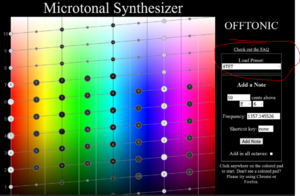
There you can pick a microtonal tuning (circled in red on the right of the image when expanded here), and play the notes with your computer QWERTY keyboard. (the thing you type articles on, not a musical keyboard.) It's even polyphonic.
This is a great resource; it's a way to dip your toe in the microtonal waters without even buying anything at all.
Unfortunately there are no other sound presets, so if you get discouraged by that, try Sevish's Scala Workshop synth.

Scala Workshop is also browser based, also polyphonic, and also played with your QWERTY keyboard. It's not as pretty as Offtonic, but so what? While it is a tiny bit more complex to use, it does have some good sounds, several sound options, + it can make, import, and export Scala files too. (More on Scala, and on Sevish, in a bit.) It even has the ability to add some delay.
Third in-browser choice is WebSynths:
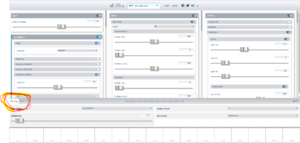
This one is polyphonic, has support for different synth sounds, and can be played with a QWERTY keyboard. But it can also be played with a MIDI controller, if you're using Chrome, and you reload the page after plugging in the keyboard.
If you click on the image above to expand it, I've circled the place you change the tuning, and change MIDI settings. (Tip: most MIDI keyboards will work on MIDI channel 1.) I didn't see that at first. For some reason, I was scrolling through the other three menus.
This is a nice web synth with some microtonal capacity.
Another good browser-based resource to check out is the Xenharmonic Ear Trainer. XenEarTrainer guides you to improve microtonal pitch perception, music theory, and understanding of musical tuning.
OK, now that you've tried web synths, do you want to play microtonal music using heavy synth sounds in a DAW with a VST?:
METHOD 2: USING MICROTONAL VST PLUG-INS IN YOUR DAW
This is a place where Windows users are in a better position than Mac or Linux users, but there is some hope for the latter. I'm going to go into detail for Windows. Linux users should check out this article on Amsynth new version. That article is by Sevish, a very good microtonal musician. He exemplifies how a lot of people in the xenharmonic community really go out of their ways to help, and teach, others. For free. For the love of the xenharmonic game.
Check out his blog even if you're not on Linux. It's full of all sorts of cross-platform microtonal info.
Simple Microtonal Synth has a free Mac version.
Amsynth is a Linux and Mac software synth that supports microtonal tunings in the latest versions:
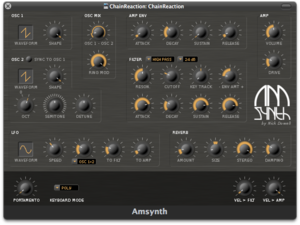
SFORZANDO This is good, free, and works in Windows and Mac. It will even work in Pro Tools on a Mac, which very little microtonal software will do.
Sforzando is free from Plogue. It's not primarily microtonal, but can import .scl tuning files from Settings / Scale File / Set:
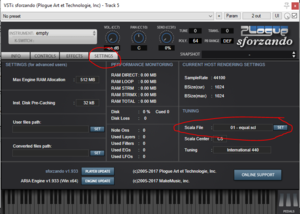
You can download a bunch of .scl files free, here. And here's a list of info on each of the files.
Or you can make .scl tuning files in Scala, a free open-source program explained a little further in this article.
Other than the VSTs that I make the only other Windows VST I regularly use for microtonal music is Sforzando.
Mac users can check out LinPlug Morphox. It costs, but there's a free working demo. It has some built-in microtonal settings. FYI, they've stopped developing new versions, but you can still get it for now. Mac users can also use the cool free soft synth Sforzando.
Here's a list of most of the microtonal software for all three main operating systems. Though the next two options I'll discuss here are the only ones that are stable, free, incredibly easy to use, and contain 5000+ tuning files built-in. (They're called tuning files, even though they are technically microtonal system files.)
For Windows user, here's what I use:
MICROTONAL POLY WORMS, and MICROTONAL POLYPHONIC SHINY DIRT
The microtonal Windows software a lot of people used to use was the VSTs from Xen-Arts. They've ceased development, their site is 404. And while these programs were great at one time, they crash 64-bit DAWs if you add more than one instance of them.
They also don't hold the microtonal system / tuning / scale you pick when you close your DAW. It often reverts each track to 12 TET when you close a project or close the DAW. (A few other VST synths have that issue also.)
And the Xen-Arts offerings they don't hold the microtonal system / tuning / scale you pick when you close your DAW. They often revert each track to 12 TET when you close a project or close the DAW. This issue is so crazy making and project-wrecking that it's a deal breaker for me. So I made my own VSTs. Mine keep their tunings, are robust, don't sound like anything else, plus they're also a lot of fun.
Both of my 32-bit Windows VSTs are synths, but both tested fine on 64-bit Reaper, and of course also on 32-bit Reaper. And tested as working well on Cubase, both 32-bit and 64-bit. And Acid. They should work on any 32-bit Windows DAW, and on many 64-bit Windows DAWs.
And now I've added some 64-bit VSTs, and one soft synth for Mac.
Reaper is my favorite and only recommended DAW. It's available for Windows, Mac, and is now in beta for Linux. Though my VSTs will only run on the Windows version (except my one Mac soft synth, Mac version of 'Simple Microtonal Synth', which will run in the Mac Reaper).
Reaper is free to try a full-featured version, and only 60 dollars US to register. (225 for commercial license, but it's the same program.) And it's updated far more often than the DAW you're probably using now.
Simple Microtonal Synth
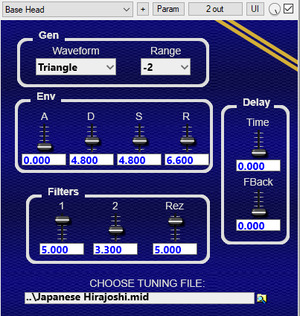
I made this to be the easiest to use microtonal VST, ever. Plus, it's free, and it's the only free 64-bit microtonal polyphonic VST. Get it here, and the simple directions are on that page too.
The 32-bit version works on Reaper 64-bit too, as well as most Windows 64-bit DAWs. There's also a 64-bit Windows version, and a Mac version. Both are free.
Microtonal Poly Worms
The first VST soft synth I made is called Microtonal Poly Worms. You can download it free, here.
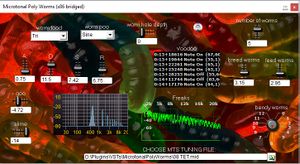
This is the more straightforward in sound of the two. It sounds a lot like an old Moog. Here's a YouTube video with a run-through of the sounds.
It has 5374 tuning files, (FAR more than any other VST or hardware synth, except for my other VST, which has the same tuning files.)
It has 64 presets. It's polyphonic, microtonal, free, easy to use, and robust.
I'm only going to do a tutorial for one of these two, because the installation and use of both is pretty much identical.
Also, both of them come with a collection of PDFs by Sevish about some of the various microtonal systems / tuning files included. They're technically deep, but easy to read, and even fun. He's a good teacher.
For a microtonal sampler, check out Simple Microtonal Sampler, 64-bit Windows. It's free.
Microtonal Polyphonic Shiny Dirt
Another free microtonal polyphonic VST I made is called Microtonal Polyphonic Shiny Dirt. You can download it here.
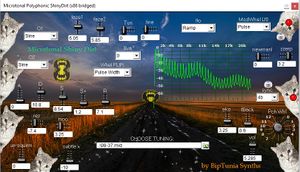
Microtonal Polyphonic Shiny Dirt is a bit more experimental and freaky than Microtonal Poly Worms. It's been called "a very musical homage to circuit-bent analog synths.'
Plus, I set up the mod wheel to do something very different and very strange on every one of the 128 presets.
The album Microtonal Cats from Alpha-Centauri uses only these two synths, other than a couple drum samplers used for the drums.
Either of these synths can also do 12 TET. Just pick the 12 EDO tuning file.
For our purposes here, and largely in naming microtonal tuning systems in a board way, EDO is the same as TET. Though, as Joseph Monzo has pointed out, "TET refers to a temperament of Just Intonation in which unison-vectors are tempered out, whereas EDO or EDn (where n is an integer or ratio) simply refers to an equal division of the octave or n without any particular reference to JI or any of its theoretical underpinning. More links on the nuance of this are here with more here.)
GETTING STARTED WITH THESE WINDOWS VSTs
Unzip and put the folder
\MicrotonalPolyphonicShinyDirt
inside your DAW's VST folder. In 64-bit Reaper, the presets will show up in a second window, like this, with the pre-sets in a separate window:
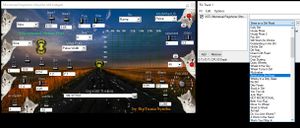
(^ If the preset window on the right isn't wide enough to see all the preset names, you can grab either side of it with your mouse, hold down the left mouse button, and drag the window wider. This is at 2:20 in my second run-through video.)
If you can't even see the main colorful window with the kitties, click the button on the VST picker that says 'Show UI' (user interface):
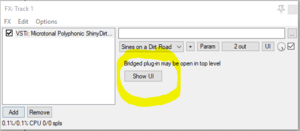
GETTING TO KNOW Microtonal Polyphonic Shiny Dirt
SO....This VST has 128 presets, and 5,376 tunings (scale files, in .MTS format).
The first 32 pre-sets are microtonal. The rest are in normal tuning, but will retain the last microtonal tuning you used, until you set your own tuning (more on that in a moment).
Each preset has a different tuning, but you can use the picker to add any of the tunings to any of the presets. You can also make your own synth patches. And, if 5,376 tunings isn't enough, you can add your own tunings. They should be in .MTS file format, put into the
\MicrotonalPolyphonicShinyDirt
folder inside your VST folder.
The order of .MTS files in our presets are set up somewhat randomly, to encourage experimentation. But you can stop using the set tunings in a given preset at any time, and pick your own. You do this by clicking on the file picker near the bottom right, on the 'CHOOSE MTS TUNING FILES' section at the bottom, and picking any of the 5,376 scales.
(Check out Sevish's Resources for Microtonal Musicians page.)
If you read about a tuning you like and want to try it, you can click the file picker icon in the bottom right of the User Interface, circled here in blue:
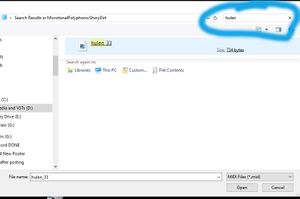
This will open up the list of tuning .MTS files. From there you can just go down the list and try different scales, or you can find specific ones; there is a search function where you can type the scale name. It will bring up your result or results.
From there, click on the file icon to use the scale. (Where it says hulen_33' in the above image. But that will be replaced by the name you searched.)
Tip: If you want to play in typical western 12-tone equal temperament, pick setting 33, called 'NOT MICROTONAL.'
------------------------------
WHEEL CHOICE PANEL
PM DEPTH Zzerp
INPUT 1 Newman
PITCH Moo
RESONANCE Rez
SIGNAL (Moog, signal – not on panel)
PHASE MOD Subtle
MODULATION fBack - (is delay feedback.)
PULSE WIDTH LFO drop down, bottom choice.
---
Microtonal Polyphonic Shiny Dirt has a cool frequency meter. This is a diagnostic tool used while making a VST, but usually removed before outputting for the public. I like it, so left it in. It's stoney and groovy. But they also teach you a bit about how this all works, and what audio synthesis actually is.
The mod wheel on Microtonal Polyphonic Shiny Dirt is unique. It controls a combination of sustain, phase mod, and pulse width. It's somewhat more subtle than many expect from a usual mod wheel, but very useful in creating a shimmer or vibrato by hand.
The mod wheel will do more on some presets and patches than on others.
And will do more in some octaves than on others. We recommend you try patches and tunings you like in different octaves as well. And with single notes, two- and three-note chords, and also try chords with more notes.
This synth will also produce very interesting results with an arpeggiator. Try it!
The pitch wheel on your MIDI controller will control pitch. The amount you can bend with it is different on some presets, and can be changed manually with the 'Pitch Wheel' switch.
Alright! Make some music then let's get into some maths and a free tool for visualizing said maths.
SCALA IS A SWISS ARMY KNIFE FOR MICROTONAL TUNING FILES AND UNDERSTANDING SCALES IN DEPTH
Note: My VSTs use .MTS tuning files, not .scl files.
But in Scala, you can convert .scl to .MTS, but not the other way around. It can export .MTS files, but cannot import them.
Get Scala here. Scala is free software (that's also zero cost) for making and analyzing tunings. Also good for making machine-readable tuning files, and converting one format of tuning files to another. Scala is GUI but also command line with some features.
Make sure you follow the directions on the website when installing it. There are some dependencies you will likely have to download and install before you install Scala.
Scala is also great for analyzing microtonal tuning systems, if you want to delve into the maths. Just create or import a scale file, then try the different options from the choice at the top of the menu file. Or you can just hit F7, F8, and F9 keys on your computer keyboard.
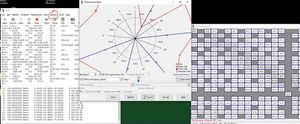
Note that you can play a scale in Scala with your mouse, to get a feel for it. You can do this in Chromatic Clavier (F4 key), or Tonality Diamond (CTRL + F9) + sound button. Also in Triad Player (F9) and a few other of the functions. Sounds are basic, Piano, Organ, etc, but are not bad sounding, and you can pick from a few sounds.
There are whispered tales that you can actually use Scala to re-tune some hardware or software synths live on the fly, but I've never seen it done, and the description of the process is daunting. If someone can put that into a no-brainer VST, they'll make dozens of dollars. At least. Hey, I might pay 24 dollars for that if it existed.
Text and pix tutorial by Sevish: How to create a .tun file in Scala (also has info on exporting to other scale formats.)
Video tutorial by Sevish: How to make and export microtonal tuning files using Scala
Scala Tutorial on bulk conversions in from .scl to .MTS (or .scl to .tun, etc.) This is something I wrote after having to figure out how to do that for making the .MTS files for my VST synths.
Below is a small amount of the info Scala returns on one scale. Before I scare you off with math you don't need to know in order to play microtonal music (though it helps), here is some very useful info:
PRO TIP: Don't be afraid to experiment with microtonal music if you don't yet understand the math.
While eventually learning the math is good, and we included resources for that. And with this VST, no math is even needed to start making cool microtonal music.
In fact, an ability to create compelling music with a tiny bit of understanding of microtones will go much further than the opposite.
